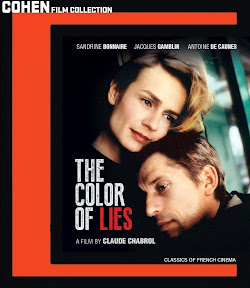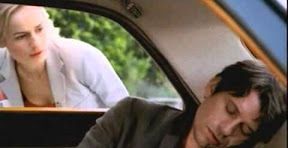"Thank God lies exist or society would be hell to live in," journalist Germain-Roland Desmot (played by Antoine de Caunes) surmises in the aptly named psychological thriller The Color of Lies from Hitchcock obsessed French New Wave forefather Claude Chabrol.
In addition to serving as a memorable piece of dialogue, when taken out of context (on a meta-level) Desmot might just as well have been arguing about the importance of cinema which offers viewers a chance to escape the pressures of society with stories comprised of beautiful lies.
Yet at the same time and much more specifically, the line reflects the modus operandi of the film’s director.
Over the course of roughly fifty years, Chabrol has constructed a collection of productions that manage to tell us something true by way of so many lies – setting all of his movies in that gray area between fact and fiction and letting his viewers reach their own conclusions for themselves.
"The most profitable lie," Desmot continues in Lies, "is when you make a liar think you believe him," and that’s exactly what sets a Chabrol picture apart as they fly in the face of the traditional three act structure of protagonist-focused hero's journeys that most Hollywood filmmakers utilize again and again.
In a Chabrol movie everyone is guilty but just what they’re guilty of is the bigger question and the one that propels not only the overall narrative but the viewer right along with it.
For even his main characters cannot be implicitly trusted as the only difference between a Chabrol hero and a villain (if there’s one you can definitely describe as either) is that the villain is somehow caught, arrested or merely found out.
Less interested in the solutions of the crimes than the truth behind the surface level lies that all of the characters live by, the final revelations in a Chabrol narrative sometimes occur as a near-afterthought.
And more often than not the bigger picture of the resolutions are nowhere near as exciting as the individual puzzle pieces he lets us discover and uncover along the way during another morally complex journey of truth and lies, before and after, rumors and suspicion as we sift through endless red-herrings in the hope of catching a killer red-handed.
One of the strongest contemporary chillers of Chabrol's enviable career, 1999’s The Color of Lies is making its U.S. Blu-ray debut fifteen years after it bowed at film fests around the world.
Sure to attract devotees of small town and village mysteries like Midsomer Murders, The Killing, and Broadchurch, despite the fact that the inspector tackling the shocking case of a murdered ten year old girl seems completely out of her depth, Chabrol puts us center stage for the drama that follows.
Instead of following the investigation directly, he takes us directly into the home of the number one suspect – the last man to see the girl alive in the form of her art teacher Rene Sterne (a stellar Jacques Gamblin).
Through Rene’s eyes we see the way the case turns everyone into an aspiring detective and amateur theorist. But of all the townsfolk, none appear more suspicious the morally questionable, cocky and condescending media commentator Desmot, who uses the case as an opportunity to get closer to Rene’s wife, Vivianne (the lovely Sandrine Bonnaire) who’d nursed him back to health when he was a former patient of hers years earlier.
A film where the whispers are louder than its shouts, where camera angle point-of-view, costumes and even the most seemingly benign lines of throwaway dialogue are filled with layers of double meaning, Color invites us to speculate what any given character might be capable of at nearly every turn.
Yet far from just staying in the shadows, the air of danger is brought back to the surface in a fascinating subplot Chabrol introduces late into the second act that makes us question everything that had come before it.
And it’s a smart move on behalf of co-scripter/director Chabrol (who penned the film along with Odile Barski) since par for the course of the filmmaker, the obligatory confession scene that identifies the child's killer is as perfunctory as it is anticlimactic when contrasted with the rest of the picture.
Nonetheless it hardly matters as by that point he’s hooked us so successfully in this believable account of lies that we’re ultimately much more riveted by the domino effect that the first crime had on the rest of the eccentric cast of characters than we could ever be in a simple cut and dried conclusion.
Relishing as much in a person’s sincerity as he does in their capacity for deception, with the hypnotically bright Color of Lies, Claude Chabrol has painted a provocative portrait of the way that passion and paranoia can push an individual (like the couple at the heart of the picture) into the darkest parts of their souls.
Text ©2014, Film Intuition, LLC; All Rights Reserved. http://www.filmintuition.com Unauthorized Reproduction or Publication Elsewhere is Strictly Prohibited and in violation of the Digital Millennium Copyright Act. FTC Disclosure: Per standard professional practice, I may have received a review copy of this title in order to evaluate it for my readers, which had no impact whatsoever on whether or not it received a favorable or unfavorable critique.



















